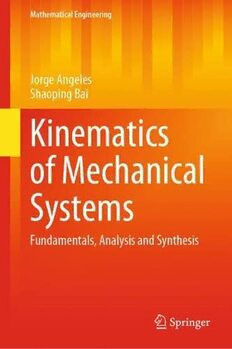Table Of ContentMathematical Engineering
Jorge Angeles
Shaoping Bai
Kinematics
of Mechanical
Systems
Fundamentals, Analysis and Synthesis
Mathematical Engineering
SeriesEditors
JörgSchröder,InstituteofMechanics,UniversityofDuisburg-Essen,Essen,
Germany
BernhardWeigand,InstituteofAerospaceThermodynamics,
UniversityofStuttgart,Stuttgart,Germany
Jan-PhilipSchmidt,UniversitätofHeidelberg,Heidelberg,Germany
AdvisoryEditors
GünterBrenn,InstitutfürStrömungslehreundWärmeübertragung,TUGraz,Graz,
Austria
DavidKatoshevski,Ben-GurionUniversityoftheNegev,Beer-Sheva,Israel
JeanLevine,CAS-MathematiquesetSystemes,MINES-ParsTech,Fontainebleau,
France
GabrielWittum,Goethe-UniversityFrankfurtamMain,FrankfurtamMain,
Germany
BassamYounis,CivilandEnvironmentalEngineering,UniversityofCalifornia,
Davis,Davis,CA,USA
Today,thedevelopmentofhigh-techsystemsisunthinkablewithoutmathematical
modeling and analysis of system behavior. As such, many fields in the modern
engineering sciences (e.g. control engineering, communications engineering,
mechanicalengineering,androbotics)callforsophisticatedmathematicalmethods
inordertosolvethetasksathand.
The series Mathematical Engineering presents new or heretofore little-known
methods to support engineers in finding suitable answers to their questions,
presentingthosemethodsinsuchmannerastomakethemideallycomprehensible
andapplicableinpractice.
Therefore,theprimaryfocusis—withoutneglectingmathematicalaccuracy—on
comprehensibilityandreal-worldapplicability.
Tosubmitaproposalorrequestfurtherinformation,pleaseusethePDFProposal
Formorcontactdirectly:Dr.ThomasDitzinger([email protected])
IndexedbySCOPUS,zbMATH,SCImago.
·
Jorge Angeles Shaoping Bai
Kinematics of Mechanical
Systems
Fundamentals, Analysis and Synthesis
JorgeAngeles ShaopingBai
DepartmentofMechanicalEngineering, DepartmentofMaterialsandProduction
CentreforIntelligentMachines AalborgUniversity
McGillUniversity Aalborg,Denmark
Montreal,QC,Canada
ISSN 2192-4732 ISSN 2192-4740 (electronic)
MathematicalEngineering
ISBN 978-3-031-09543-6 ISBN 978-3-031-09544-3 (eBook)
https://doi.org/10.1007/978-3-031-09544-3
©TheEditor(s)(ifapplicable)andTheAuthor(s),underexclusivelicensetoSpringerNature
SwitzerlandAG2022
Thisworkissubjecttocopyright.AllrightsaresolelyandexclusivelylicensedbythePublisher,whether
thewholeorpartofthematerialisconcerned,specificallytherightsoftranslation,reprinting,reuse
ofillustrations,recitation,broadcasting,reproductiononmicrofilmsorinanyotherphysicalway,and
transmissionorinformationstorageandretrieval,electronicadaptation,computersoftware,orbysimilar
ordissimilarmethodologynowknownorhereafterdeveloped.
Theuseofgeneraldescriptivenames,registerednames,trademarks,servicemarks,etc.inthispublication
doesnotimply,evenintheabsenceofaspecificstatement,thatsuchnamesareexemptfromtherelevant
protectivelawsandregulationsandthereforefreeforgeneraluse.
Thepublisher,theauthors,andtheeditorsaresafetoassumethattheadviceandinformationinthisbook
arebelievedtobetrueandaccurateatthedateofpublication.Neitherthepublishernortheauthorsor
theeditorsgiveawarranty,expressedorimplied,withrespecttothematerialcontainedhereinorforany
errorsoromissionsthatmayhavebeenmade.Thepublisherremainsneutralwithregardtojurisdictional
claimsinpublishedmapsandinstitutionalaffiliations.
ThisSpringerimprintispublishedbytheregisteredcompanySpringerNatureSwitzerlandAG
Theregisteredcompanyaddressis:Gewerbestrasse11,6330Cham,Switzerland
Preface
The kinematics of mechanisms is a classical discipline in the broader domain of
mechanical systems. The latter include systems of rigid and deformable solids,
while the former has mainly focused on systems of rigid bodies. Given that the
mechanics of deformable solids depends on the forces applied to the body under
study, their motion is not determined solely by the motion undergone by some of
thesystembodies.Indeed,theinterplayofforcesandmoments(wrenches)withthe
displacements of the system bodies must be taken into account via the principles
of continuum mechanics, which is a significantly broad multidiscipline, involving
fluidsanddeformablesolids.Inthismultidiscipline,therelationsbetweenwrenches
anddisplacementsareincludedviatheconstitutiveequationsrelatingthem.
On the contrary, the motion of a system of coupled rigid bodies depends only
onthemotionundergonebyagivensubsetofthebodies.Inthiscase,knowingthe
motion of that subset, the motion of all the bodies of the system is determined—
modulo the possible finite number of postures adopted by a subset of the system
bodies,aconcepttermedassemblymodes.Themechanicalsystemsofinteresttothe
bookinvolveonlyrigidbodies.
Broadly speaking, the systems of rigid bodies studied here can form open and
closed chains.Theparadigmmechanicalsystemstudiedintherealmofkinematics
is the planar four-bar linkage, composed of four rigid bodies (the links) coupled
bymeansofwhatisknownaslowerkinematicpairs (LKP).Thebookfocuseson
systems of rigid bodies forming closed loops, mainly intended for one-degree-of-
freedom (one-dof) tasks. The four-bar linkage is given due attention, in its three
domains: planar, spherical, and spatial. Multi-degree-of-freedom mechanisms of
eitheropenorclosedkinematicchainsareofutmostimportanceinrobotics.These
systemsareextensivelyandintensivelystudiedintherealmofroboticmechanical
systems,wherebyarichliteratureisavailable.
Thebookcontainssixchapters.Chapter1providesthefundamentalsforkinematic
synthesis, covering two basic concepts, synthesis-equation solving, and numerical
methods.Chapter2isdevotedtothequalitativesynthesisoflinkages,inwhichthe
layoutofkinematicchainsandpairsisconsidered,todeterminethelinkagedegreeof
freedom.Chapters3–5coverinfulldetailsingle-doflinkagesofthreemajortypes,
v
vi Preface
namelyplanar,spherical,andspatialfour-barlinkages.Theirfunctional,motionand
pathsynthesesaredescribedinsequenceinthethreechapters.Inthelastchapter,the
synthesisofsingle-dofcomplexlinkages,includingsix-barandten-barlinkages,is
introducedascasesofapplicationofthemethodologystudiedinthebook.
Our aim is to provide comprehensive and systematic knowledge of kinematic-
synthesistheoryandmethods.Thebookincludesnotonlytheclassicalfoundationsof
kinematicsynthesis,suchastheBurmestertheorem,theRoberts–Chebyshevtheorem,
andtheprincipleoftransference,butalsothelatestadvancesinthisareathatwere
made by the authors, particularly on coupler-curve synthesis. Moreover, synthesis
examples are included in the book to illustrate the synthesis theory and methods.
Thebookissuitableforgraduatestudentsofmechanicalengineering,researchersof
mechanismandrobotdesign,andmachinedesignengineers.Wetrustthatthebook
will guide and inspire engineers, researchers, and students in the design, analysis,
anddevelopmentofinnovativeandhigh-performancemachinesinallrelevantfields
ofapplications.
JorgeAngelesacknowledgesthefinancialsupportreceivedfromCanada’sNatural
Sciences and Engineering Research Council (NSERC) throughout his academic
careerinCanada.Indeed,NSERC’sDiscoveryGrant programallowedhimtohire
toptalentattheRoboticMechanicalSystemsLaboratory(RMSLab),McGillUniver-
sity,sincethemid-1980s.Variousgraduatestudentsandvisitingfellowscontributed,
withtheirwork,tothedevelopmentofideaswhich,eventually,foundtheirwayinto
thebook.AcompletelistofthesetraineesisavailableintheRMSLabwebpage.1
Shaoping Baiacknowledges Danishnational andEUfunding bodies,including
Innovationsfonden,IndependentResearchFundDenmark,andEUAALProgramme,
amongothers,forprovidingfinancialsupportforresearchininnovativemechanisms
andexoskeletonsatAalborgUniversity,Denmark.Heacknowledgesalsocollabora-
tionwithlocalindustryandinternationaluniversities,suchasPNBeslagFabricand
DalianUniversityofTechnology,amongothers,whichmotivatedresearchtopicson
linkagesynthesisandapplications.
JorgeAngeles,Ph.D.
ProfessorEmeritus,McGillUniversity
Montreal,QC,Canada
ShaopingBai,Ph.D.
Professor,AalborgUniversity
Aalborg,Denmark
1http://www.cim.mcgill.ca/:rmsl/Index/index.htm.
Contents
1 IntroductiontoKinematicSynthesis ............................. 1
1.1 TheRoleofKinematicSynthesisinMechanicalDesign .......... 1
1.2 Glossary .................................................. 5
1.3 KinematicAnalysisVersusKinematicSynthesis ................ 8
1.3.1 ASummaryofSystemsofAlgebraicEquations .......... 10
1.4 AlgebraicandComputationalTools ........................... 10
1.4.1 TheTwo-DimensionalRepresentationoftheCross
Product ............................................. 11
1.4.2 Algebraof2×2Matrices ............................. 13
1.4.3 Algebraof3×3Matrices ............................. 14
1.4.4 Linear-EquationSolving:DeterminedSystems ........... 14
1.4.5 Linear-EquationSolving:OverdeterminedSystems ....... 18
1.5 Nonlinear-EquationSolving:TheDeterminedCase .............. 29
1.5.1 TheNewton–RaphsonMethod ......................... 31
1.6 OverdeterminedNonlinearSystemsofEquations ............... 32
1.6.1 TheNewton–GaussMethod ........................... 33
1.7 PackagesRelevanttoLinkageSynthesis ....................... 36
References ..................................................... 38
2 TheQualitativeSynthesisofKinematicChains .................... 41
2.1 Notation .................................................. 41
2.2 Background ............................................... 42
2.3 KinematicPairs ............................................ 47
2.3.1 The(cid:2)KinematicPair ................................ 49
2.4 GraphRepresentationofKinematicChains ..................... 50
2.5 GroupsofDisplacements .................................... 53
2.5.1 DisplacementSubgroups .............................. 56
2.6 KinematicBonds ........................................... 60
vii
viii Contents
2.7 TheChebyshev–Grübler–Kutzbach–HervéFormula ............. 63
2.7.1 TrivialChains ....................................... 63
2.7.2 ExceptionalChains ................................... 66
2.7.3 ParadoxicalChains ................................... 69
2.8 ApplicationstoRobotics .................................... 69
2.8.1 TheSynthesisofRoboticArchitecturesandTheir
Drives .............................................. 69
References ..................................................... 73
3 LinkageSynthesisforFunctionGeneration ....................... 75
3.1 Introduction ............................................... 75
3.2 Input-Output(IO)Functions ................................. 76
3.2.1 PlanarFour-BarLinkages ............................. 76
3.2.2 TheDenavit-HartenbergNotation ...................... 79
3.2.3 SphericalFour-Bar-Linkages .......................... 80
3.2.4 SpatialFour-Bar-Linkages ............................. 86
3.3 ExactSynthesis ............................................ 91
3.3.1 PlanarLinkages ...................................... 91
3.3.2 SphericalLinkages ................................... 96
3.3.3 SpatialLinkages ..................................... 98
3.4 AnalysisoftheSynthesizedLinkage .......................... 99
3.4.1 PlanarLinkages ...................................... 99
3.4.2 SphericalFour-BarLinkages .......................... 110
3.4.3 SpatialFour-BarLinkages ............................. 113
3.5 ApproximateSynthesis ...................................... 120
3.5.1 The Approximate Synthesis of Planar Four-Bar
Linkages ............................................ 123
3.5.2 TheApproximateSynthesisofSphericalLinkages ........ 125
3.5.3 TheApproximateSynthesisofSpatialLinkages .......... 127
3.6 LinkagePerformanceEvaluation ............................. 131
3.6.1 Planar Linkages: Transmission Angle
andTransmissionQuality ............................. 131
3.6.2 Spherical Linkages: Transmission Angle
andTransmissionQuality ............................. 136
3.6.3 Spatial Linkages: Transmission Angle
andTransmissionQuality ............................. 137
3.7 DesignErrorVersusStructuralError .......................... 139
3.7.1 MinimizingtheStructuralError ........................ 142
3.7.2 Branch-SwitchingDetection ........................... 144
3.7.3 IntroducingaMassiveNumberofDataPoints ............ 145
3.8 SynthesisUnderMobilityConstraints ......................... 145
References ..................................................... 148
Contents ix
4 MotionGeneration ............................................. 151
4.1 Introduction ............................................... 151
4.2 PlanarFour-BarLinkages .................................... 151
4.2.1 DyadSynthesisforThreePoses ........................ 153
4.2.2 DyadSynthesisforFourPoses ......................... 154
4.2.3 DyadSynthesisforFivePoses ......................... 156
4.2.4 CaseStudy:SynthesisofaLandingGearMechanism ..... 158
4.2.5 ThePresenceofaPJointindyadSynthesis .............. 165
4.2.6 ApproximateSynthesis ............................... 170
4.3 SphericalFour-BarLinkages ................................. 174
4.3.1 DyadSynthesisforThreeAttitudes ..................... 177
4.3.2 DyadSynthesisforFourAttitudes ...................... 178
4.3.3 DyadSynthesisforFiveAttitudes ...................... 179
4.3.4 SphericaldyadswithaPJoint ......................... 181
4.3.5 ApproximatedyadSynthesis ........................... 181
4.3.6 Examples ........................................... 189
4.4 SpatialFour-BarLinkages ................................... 195
4.4.1 GeometricConstraintsofCCandRCdyads .............. 196
4.4.2 TheSynthesisoftheCCdyad .......................... 198
4.4.3 TheSynthesisoftheRCdyad .......................... 200
4.4.4 SynthesisofFour-BarLinkages ........................ 202
4.4.5 ASemigraphicalSolutionoftheDirectionEquations ...... 202
4.4.6 SolvingtheLinearEquationsoftheMomentVariables .... 204
4.4.7 CongruencesoftheFixedandtheMovingAxes .......... 204
4.4.8 Examples ........................................... 205
4.4.9 Summary ........................................... 208
References ..................................................... 210
5 TrajectoryGeneration .......................................... 213
5.1 PlanarLinkages ............................................ 214
5.1.1 PlanarPathGenerationwithPrescribedTiming ........... 214
5.1.2 Coupler-CurveSynthesisofPlanarFour-BarLinkages .... 221
5.2 TrajectoryGenerationforSphericalFour-BarLinkages .......... 234
5.2.1 PathSynthesiswithDiscretePositions .................. 235
5.2.2 PathSynthesiswithPrescribedTiming .................. 236
5.2.3 Examples ........................................... 237
5.2.4 Summary ........................................... 240
5.3 PathGenerationforRCCCLinkages .......................... 240
5.3.1 AGenericRCCCLinkage ............................. 240
5.3.2 AnAlternativeCoordinateFrame ...................... 242
5.3.3 ConstraintEquationsoftheCCandRCdyads ............ 243
5.3.4 N-pointPathSynthesis ................................ 245
5.3.5 Example ............................................ 247
5.3.6 Summary ........................................... 249
References ..................................................... 249

